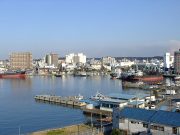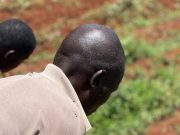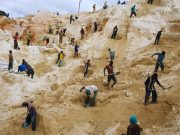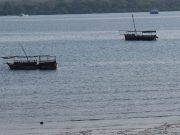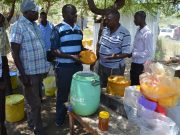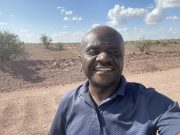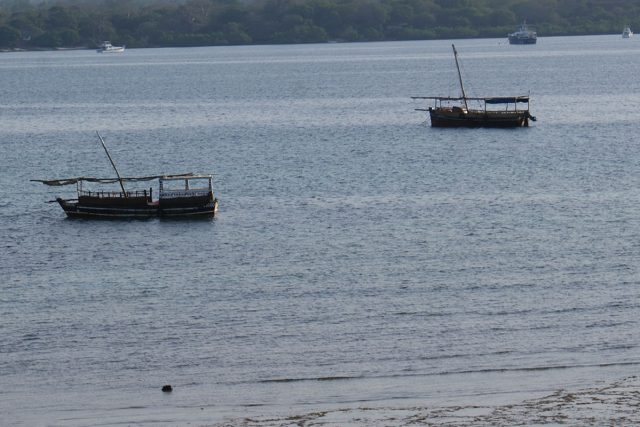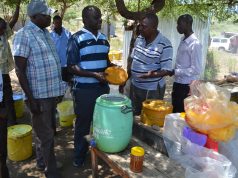I first felt Wasini’s thirst in the silence after a boat leaves. The engine coughs, the wake settles, and the channel between Shimoni and the island goes back to looking innocent. Then you notice the colors that tell the truth. Yellow jerrycans flash in the sun like warning lights. Corrugated roofs burn white. The coral ground is the color of bone. Even the children’s laughter sounds brittle, as if too much joy might crack the day and spill it into the sea.
I have been to too many Kenyan villages where water is a walk away, a well away, a pipe away. Wasini is not one of them. It sits on fossil coral, ancient reef lifted by time and tide until it became a place to live and pray and cook and make boats, but not a place to dig. Here a spade does not promise a spring. It promises salt. You cannot chase freshwater underground because the ground is porous limestone that drinks the rain and gives it back to the ocean. Any sweet pocket you find after a storm sours in days. The island does not keep a secret of water. It never has.
This is the first truth. Wasini’s scarcity is not a moral failure. It is a geological sentence. The island does not have a freshwater lens as some islands do. It cannot be rescued by the simple heroism of a borehole. The borehole is a myth here, and myths are dangerous when they are written into budgets and spoken on podiums.
So people build their hope above the ground. Over years, through the stubborn mercy of outsiders and the disciplined work of locals, Wasini learned to catch rain. Concrete bellies were shaped into the earth, their mouths opened to rooftops and catchment yards. When the long rains come as Kaskazi and the short ones as Kusi, the water runs, and if gutters are true and the first flush is clean, the bellies fill. I have stood beside those tanks as women open valves the way a priest opens a tabernacle. I have watched the men whose hands poured that concrete run their fingers along a hairline crack like doctors reading a pulse. People talk to those tanks as you talk to a beloved elder. They know when one is sulking, when one is singing.
And yet you know a love story is fragile when it only works in fair weather. The tanks keep Wasini alive, but they are brittle. Concrete ages. Rebar rusts. Seals fail. Salt air accelerates everything you wish would slow down. A tank is hydrostatic pressure wearing a mask of stillness. The same weight that is life for the island is also the slow force that opens a seam and lets life drip away. Repair is not a one-off act. It is a habit. It needs money and skill and a calendar that someone respects. Too often it meets a donation that was generous, a ribbon that was cut, and then a silence no tank can drink.
There was, however, one recent effort to break that silence. Between February and August 2025, three of Wasini’s largest tanks were brought back from the brink. Cracks were sealed, roofs rebuilt, gutters and downpipes fixed so that rain could once again be caught and kept. It was back-breaking work: cement, iron sheets, and timber ferried in small boats, sand lugged across coral in 50-kilo sacks, and men and women sweating under the equatorial sun to carry the pieces of survival uphill. Young masons learned as they labored, mentored in the craft of waterproofing and reinforcement, and by the time the last coat of plaster dried, the island’s water belly was restored to 472,000 liters.
The effect was felt immediately. Families walked shorter distances, children drank from cleaner taps, mothers worried less about cholera and typhoid. For a moment, water felt nearer, safer, almost abundant. And yet, to end the story here would be to mistake a reprieve for deliverance. Those 472,000 liters seem vast until you watch an island of three thousand people drink them down. Salt air still chews through iron, cracks will return, and the pressure of life will pry open the seams again. The refurbishment was proof of what grit and modest funds can achieve, but also a reminder of limits. Wasini bought time, not freedom. Without a new covenant between rain, sun, and sea—rooftop tanks in every homestead, and solar desalination scaled to community level—the island will circle back to thirst. Even success can be not enough.
There is the other layer of danger: we tell ourselves rainwater is pure because it falls from heaven. But heaven shares the air with dust and bird droppings, and the first roof a drop meets might be a field of microbes. Tanks gather not just water but everything water carries. Sediment settles into a dark film on the floor. Biofilms bloom on walls. A cistern must be cleaned the way a body must be washed. Empty it, scrub it, disinfect it, dry it, watch the weather, and plan for the day the tap runs quiet because you cleaned when you should have hoarded. That is the arithmetic of survival here: balancing sanitation against scarcity, always gambling against the sky.
Even success breeds pressure. When the tanks worked, babies lived. When babies lived, they grew. When people had more confidence, they built. Staircases rose. New rooms appeared. Guesthouses opened because the sea here is filled with dolphins and coral gardens, and the world wants to come and see and leave. The same system that made Wasini more livable made Wasini more demanding of it. This is development’s paradox: you solve a problem and the solution multiplies the very demand it was meant to satisfy.
What makes this story tragic is not the hardship alone but the distance of policy from reality. Our national imagination of water is a map of rivers engineered into obedience. We favor concrete spectacles that hold valleys in their hands and pipes that run like arteries toward our cities. We write master plans that make sense on a continental scale and forget islands that do not fit the template. County governments inherit the problem and the paralysis. A barge appears, makes a single delivery, vanishes. A committee meets and asks how to pipe water under the sea as if the question itself is an answer. On paper, Wasini is a line item. On the ground, it is a woman counting coins for a boat ride to fetch two jerrycans, because a household that is poor cannot drink plans.
Scarcity here is not abstract. It tastes like the brine that seeps into a shallow well after a storm. It sounds like the hollow thud of an empty tank when a hand slaps it and hopes it is not empty. It looks like a child with a fever that might be typhoid, and the clinic that has clean hands but too little clean water. It is a pit latrine cut into coral, because where else will you put it, and the tide that pulls waste through porous rock back to the beaches where children play. The island is a circulatory system with bad valves. Pathogens do not respect the distance between a latrine and a cistern. They travel the shortcuts of physics and end up in a cup.
Let us talk about cost with the bluntness it deserves. A Wasini family buys water by the jerrycan, carries it by the back, counts it by the cup. Thirty shillings is the price of twenty liters delivered by sea. Do the math across a month, across a dry season, across a year that fails. Compare it to Nairobi, where a thousand liters piped to your house might cost less than what Wasini pays for a day’s drinking water. Poverty here is not just a lack of money. It is the penalty a poor community pays to survive an infrastructure that never came.
And because we are honest, we will say who pays with their bodies. Women and girls carry the heaviest part of this island. They queue at dawn. They balance weight across shoulders, hips, necks. They miss class, miss work, miss sleep, and risk more than fatigue on dark paths and crowded waiting places. The musculoskeletal injuries of water are not in the newspapers. The fear in a girl’s chest when she returns late because the queue was long is not in our development plans. The stress in a mother’s mind when she lies down and calculates if the remaining liters will be enough to bathe a fevered child is not in any budget line. But those costs are paid every day and they compound like interest.
What, then, is to be done if we are to end this crisis once and for all, and not just manage it with seasonal piety?
We start by accepting the island for what it is. We stop promising impossible boreholes and begin building systems that honor the truth of coral. We think in two streams. One stream falls from the sky. The other rises from the sea, sweetened by science and powered by sun. Between them, if we are disciplined and imaginative, lies a permanent solution.
First, rain that falls free must be caught better, stored smarter, and kept safer. The large community cisterns need the kind of care we lavish on our favorite machines: a schedule, a trained hand, a ring-fenced budget. Commission a structural audit of every tank. Seal the cracks with materials that stand up to salt. Replace failing gutters. Install first-flush diverters that throw away the dirty beginning of a storm. Standardize screens. Set cleaning windows on the calendar before they turn into crises on the ground. And because repairs cost money, create a maintenance fund that belongs to the community, is governed in daylight, and is fed by modest, predictable fees. A tank that leaks is not just bad luck. It is bad accounting.
Second, stop pretending that a handful of community tanks can shoulder an island forever. Every roof should be a catchment. If each household had a sturdy gutter and a ten-thousand-liter tank, resilience would live at the doorstep. The communal tanks would stop being asked to do what only neighborhoods can do for themselves. Microfinance is not charity by another name. It is a way to unlock dignity at scale. We have seen Kenyans repay small loans for water assets with a rigor that shames the stereotypes about the poor. Bring those products to Wasini with terms that make sense for fishermen, shopkeepers, widows, and the families that hold them together.
Third, admit the monsoon cannot be trusted as a sole source in a warming world. This is where I let myself feel something like joy, because technology has finally humbled the old argument that desalination is only for the rich. Solar-powered reverse osmosis in shipping-container kiosks has changed the game. The model is simple and beautiful. You capture the sun that punishes you. You feed it to membranes that strip salt from the sea. You sell clean water at a price that undercuts the tyranny of the jerrycan economy. No diesel. No grid. No smoke. Parts that can be replaced. Systems that can be taught, and then taught again until they belong to the island’s own technicians.
Wasini already has one such kiosk. It should not be a pilot forever. Scale it with intent. Place them where people live, not where planners think they should walk. Train a small corps of island engineers and pay them decently. If we can train young people to maintain outboard engines and smartphones, we can train them to maintain pumps and membranes. Make the supply chain for filters and parts as real as the one for sugar and flour. Plan for brine disposal that respects the sea that feeds Wasini’s table. If we treat desalination as a community utility rather than a trophy plant, it will repay us in health, time, and peace of mind.
The long horizon is a hybrid that behaves like an orchestra rather than a soloist. Rainwater should always be the first violin, playing whenever the sky allows, stored in thousands of small tanks and a handful of reliable big ones, protected by hygiene that is not negotiable. Solar desal should be the percussion, steady and metronomic, assuring a baseline supply through the cruelest dry months and stepping back when the island is flush. The conductor is a water plan written by the island for the island, with help where help is needed, but authored in Wasini’s own voice.
Governance must catch up with courage. Kwale County should stop being puzzled and start being practical. Co-finance household tanks. Guarantee the maintenance fund. Write Wasini into the County Integrated Development Plan not as an asterisk but as a model for how to serve communities that do not fit the mold. And at the national level, we need an Off-Grid Community Water Policy that stops pretending one size fits all. The same country that builds tunnels costed in billions can also build dignity in places counted in thousands. It is not either-or. It is called being a nation.
Let me be very clear about the payoff. End the water crisis and you defuse a health emergency. Typhoid becomes rare instead of routine. Cholera becomes a headline from somewhere else. Pit latrines stop bleeding into the shallows because sanitation can be upgraded when water is not a luxury. Girls grow taller, not just because they are healthier but because they carry less weight over fewer kilometers. Women start businesses with the hours they gain back from the water queue. Tourists come for the coral gardens but leave with respect for an island that solved a problem the world told them was permanent. And those yellow jerrycans? They stop being the flag of scarcity. They become what they should have been all along: containers.
I know this sounds like a lot. It is. But it is also precise, measurable, and possible. Audit. Repair. Fund. Gutter. Tank. Train. Kiosk. Plan. Policy. If we sequence these ten words over the next ten years, Wasini’s thirst becomes history.
I keep thinking about one conversation under a roof that had no gutter. The woman I was talking to glanced up when a wind rattled the sheet metal. She did not look at me when she said it. “When it finally rains, I hear the sound differently. I hear it as a waste.” That sentence pierced me. Rain should sound like grace, not guilt.
Let us change that sound. Let rain on Wasini be the drumbeat of a solved problem, not the soundtrack of anxiety. Let the sea, which once made this place into a reef, now give it water to drink without the taste of salt. Let concrete be a servant and never a tyrant. Let government learn from community, and community demand better from government. Let the island that tourists visit for its dolphins become famous for its discipline.
I am DJ Bwakali. Africa is my superpower, and so is the clarity to say that some fights can be won if we stop romanticizing struggle and start designing solutions that fit the ground beneath our feet. Wasini’s water crisis is not a riddle. It is an equation. We have all the numbers. Now we do the math.





